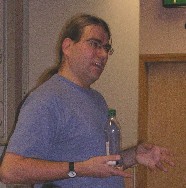 The University of Oregon’s What is Radio conference (#whatisradio) wrapped up on Saturday, with many interesting panels on the last day. One of the best was named “Web Radio: Say Goodbye to the Dial.” But a fascinating talk by Dr. Neil Washbourne from Leeds Metropolitan University convinced me that, given the case of WQXR in New York City, classical music radio lovers won’t be saying goodbye to the dial any time soon.
The University of Oregon’s What is Radio conference (#whatisradio) wrapped up on Saturday, with many interesting panels on the last day. One of the best was named “Web Radio: Say Goodbye to the Dial.” But a fascinating talk by Dr. Neil Washbourne from Leeds Metropolitan University convinced me that, given the case of WQXR in New York City, classical music radio lovers won’t be saying goodbye to the dial any time soon.
Washbourne’s presentation was titled “New York City’s Classical 105.9 WQXR-FM: the asymmetrical complementariness of its on-air and online worlds.” That means that while WQXR sees the relationship between its website and its on-air stream as symbiotic, it is an uneven partnership, primarily informed by the necessities of the on-air signal. “On-air motives and needs predominate” at QXR, the paper concludes.
Raised in New York City, I grew up with WQXR, a hallowed classical music station serving the area since 1936. The New York Times purchased the frequency in 1944, and put it up for sale during the economic crisis of 2009. New York Public Radio bought it and turned it into a public radio signal in October of that year.
Across the United States, classical radio already faced huge pressures, accelerated by the Great Recession. As KUSC’s Brenda Barnes told me in 2010, following the deregulation of radio in 1996, many classical radio operators saw an opportunity to sell their frequencies at far above market value.
“So they sold, and once you buy a big station in a big market for $100 million or $60 million or whatever, you can’t afford to run it as a classical station, because you can’t make enough money back to pay the debt load,” she explained. “That sort of triggered the end of commercial classical radio. And what’s been happening is a trend toward public radio kind of trying to fill that void.”
In that context, public WQXR deploys online features to smoothe out and supplement the on-air experience. To avoid annoying listeners with pledge drive pitches, staff urge listeners to pledge on the website, thus dodging the need to “interrupt your listening.” As a result, over half of subscribers pledged online in the October 2010 drive. This gave WQXR database details about them, allowing the station to “target future pledge activities and consider which geographical areas and social groups may be under-represented amongst subscribers.”
“More broadly,” Washburne adds, “the fundamental aim of online supplementation of the station is to give listeners such a rich experience that they fear losing what the station offers and, thereby, feel increasingly obligated to pay.” This includes “Q2”—an online stream of more “adventurous” music from living classical composers.
“There is significant interaction between on-air and online output of WQXR (and Q2),” Washburne writes. “For example, some sections from the Q2 stream are put on air in WQXR late on Saturday nights—so a taster and to encourage listening across streams and, thereby, transform listener taste and knowledge.” The station streams live performances both on air and online sometimes, as in the “Trout Week” chamber music festival of 2011. Blogs encourage listeners to share information.
But: “In spite of these attempts to encourage listening to Q2, WQXR is still very much more listened to and engaged with than Q2,” he notes. This can be measured by the attention paid to various blogs. Washburne found four times as many blog discussions initiated on WQXR than on Q2, whose function he identifies as an “arena for the creative activity and job fulfillment of presenters [or as we would put here in the states, the deejays].”
This is the ‘asymmetricality’ of which Washburne speaks—a web presence in the service of an on air stream, a relationship “predominantly guided by the on-air presence and requirements to generate subscribing listeners out of listeners.” The paper concludes with this intriguing last sentence:
“Though currently the case is that on-air motives and needs predominate, the power of the productive, communicative and distributional resources of web radio open up all sorts of more utopian, imaginative possibilities for WQXR in the future in which its locatedness in New York City will form more a symbolic and cultural resource for otherwise delocated, national and translocal relations.”
I am conflicted by this conclusion. On one level, I want and am comforted by the idea of a continuous locally or regionally based analog presence for radio that remains the dominant identity. On the other hand, I want classical radio to become ever more adventurous, bold, and challenging. Ah, the choices posed by modernity . . .



